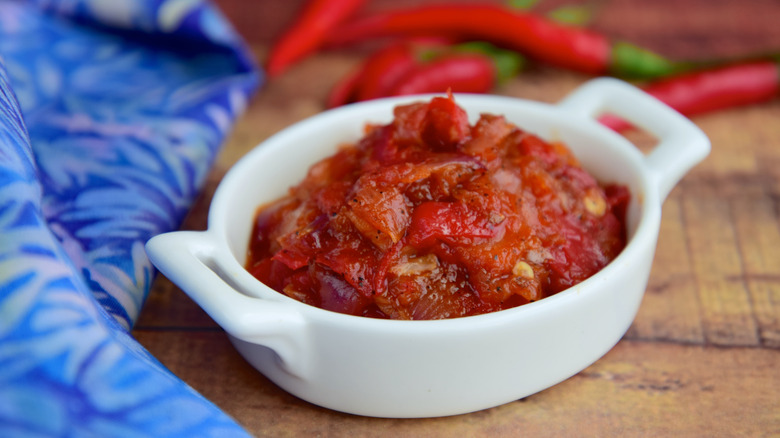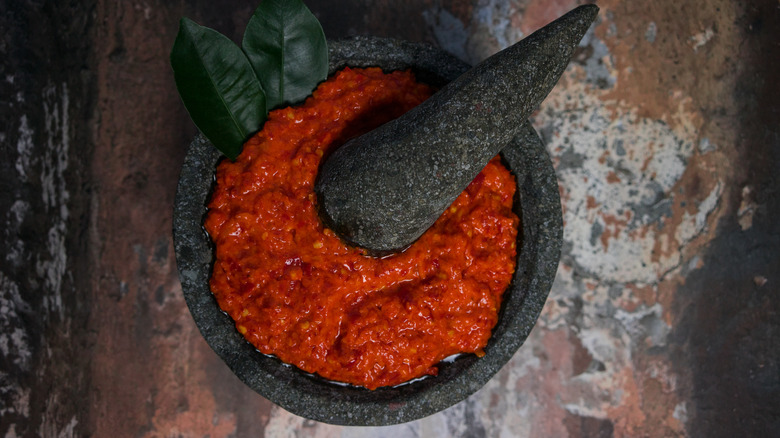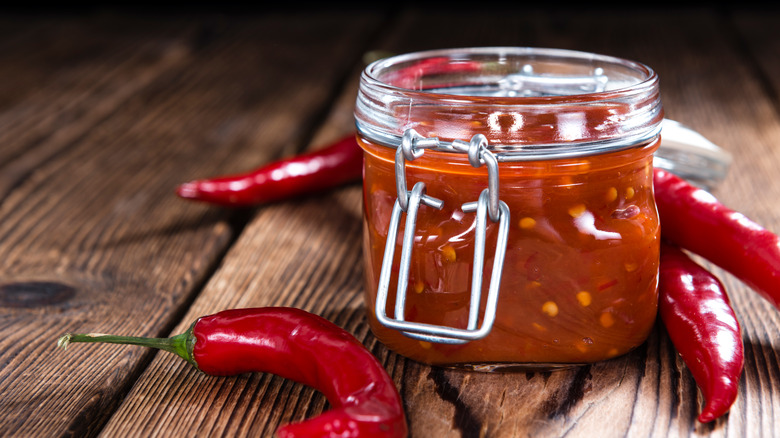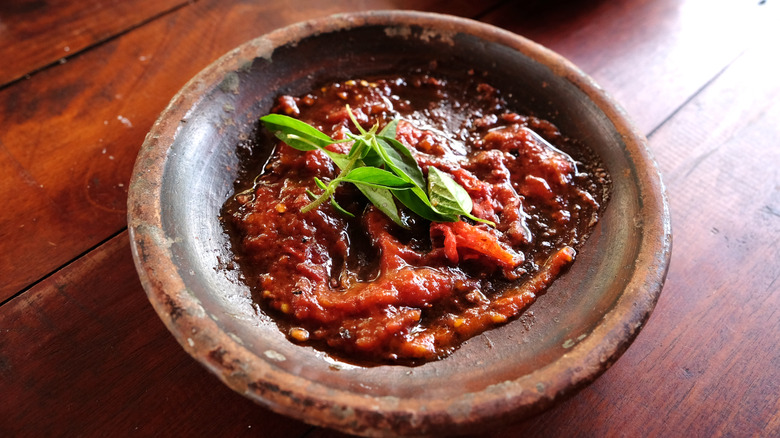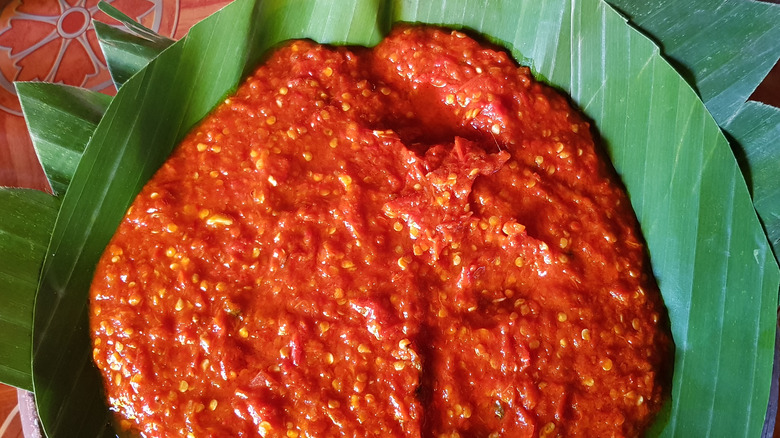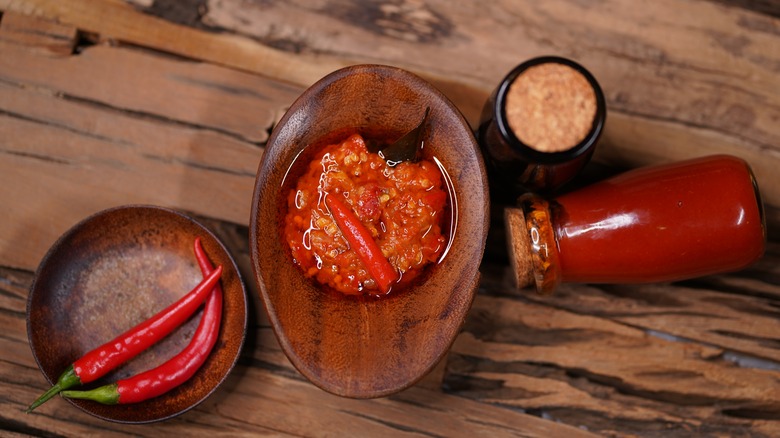What Is Sambal Oelek (And How Do I Use It?)
You may never have cooked with it, you may never have tasted it, you may never even have heard of it, but you've certainly seen it; tucked between the row of fiery red, rooster-embellished jars with green caps at supermarkets and often mistaken for sriracha is sambal oelek, a spicy Indonesian chili paste. Sambals are a type of condiment made from ground herbs and spices, of which over a hundred varieties exist in Indonesia. Much as Indian cuisine uses chutneys and Americans prefer ketchup and mustard, Indonesian cuisine relies heavily on a variety of sambals, each better suited for specific preparations. There are sambals that are made from red chilies, garlic, and shallots, as well as those that use lemongrass, shrimp paste, and makrut limes.
While sambals vary from region to region influenced by the local produce that grows there, sambal oelek is one variety that has far transcended its siblings in popularity outside of Indonesia and the Staes. Considered to be the simplest and most toned-down version of other sambals, sambal oelek is a paste-like condiment made from ground chili peppers that can be used in everything — from Southeast Asian dishes to everyday avocado toasts and eggs.
What is sambal oelek?
Sambal oelek gets its name from the Javanese word for condiment (sambal) and the Dutch interpretation (oelek) of the Indonesian word ulek, which refers to a mortar and pestle used to grind spices and make pastes. This is why sambal oelek also goes by its Indonesian name sambal ulek. At its simplest, sambal oelek is made by crushing red chili peppers and salt in a mortar and pestle as the name indicates, preferably by hand.
Looking at its core ingredient, one would consider sambal oelek to be a relatively new type of sambal, pounded together only after the Portuguese and Spanish introduced red chilies to Indonesia in the 1500s. In reality, what we now know as sambal oelek is an evolved version of a sambal made from andaliman peppers instead of red chilies that have been around for much longer. Belonging to the same family as the Szechuan pepper, andaliman pepper is native to Indonesia and is ground with local ginger and long pepper.
As sambal oelek evolved with the introduction of red chilies, its simple heat and versatility have made sambal oelek a popular condiment, particularly in the United States. In fact, it's often considered to be the entry point for the uninitiated to other more layered and nuanced pastes that exist in the world of sambals.
How is sambal oelek made and where can you buy it?
Sambal oelek is essentially made of three simple ingredients: red chilis, salt, and vinegar though it can sometimes contain oil too. The three ingredients are typically pounded by hand using a mortar and pestle — though in its absence, it's also possible to pop these ingredients in a food processor and crush them until a paste forms. Because it is easy to make and features simple flavors, sambal oelek is often used as the base for more complex sambals as well.
Homemade sambal oelek is always a good idea — especially considering how quickly it can come together — but the spicy chili paste is also available at supermarkets in abundance. Notably, the hot sauce company Huy Fong Foods — whose rooster-embellished green-capped bottles of sriracha are practically synonymous with sriracha in general — also sells jars of sambal oelek with bright yellow labels. There may also be plenty of specialty shops or Indonesian grocery stores that sell sambal oelek, but it's always wise to check the ingredients on the back first. Although there should be little besides red chilies, salt, and vinegar in your sambal oelek, some brands may use additional ingredients such as lemon, garlic, and fish sauce. Grab the flavor profile you prefer.
What does sambal oelek taste like?
Considering its star ingredient, sambal oelek has the punchy heat that is expected from spicy red chilies with a hint of tang from the vinegar. In fact, because it doesn't contain the complexity of flavors that come from fermented pastes like gochujang or those with lengthier ingredient lists such as sriracha, sambal oelek can be practically thought of as a chunkier chili spread of sorts. When used as a condiment, sambal oelek may have the faint sweetness that often laces the spiciness of red chilies and when used as an ingredient in cooking, it may mimic the flavor of fresh chilies.
That said, the exact flavor of sambal oelek may vary depending on whether you make it at home or which brand you buy — the sparse ingredient list leaves little room for other flavors to hide. Some store-bought sambal oelek can be overly salty whereas others may have a heavier hand on vinegar because it works as a natural preservative. You may even notice the heat of chilies spiked with other flavors depending on the additional ingredients featured in the bottle. On the flip side, homemade versions may taste fresher with a touch of fruitiness to them from the chilies. You can add just enough salt to brighten the flavours and make them pop, creating a more well-rounded sambal oelek.
How to use sambal oelek?
Sambal oelek is an extremely versatile chili paste: It is excellent on its own as a condiment or a dipping sauce, it can be used as a base to build more sambals, or it can be cooked along with other ingredients to spice up everyday meals. Besides, sambal oelek is key to many Southeast Asian preparations. Sambal oelek is used in nasi goreng and is often served alongside the fried rice dish as an accompaniment as well. The chili paste is used to add spice to the Vietnamese dipping sauce nuoc nam and to the Thai sauce nam jim. Similarly, you can use sambal oelek to make your own dipping sauces or add it to marinades and stir-fries.
Sambal oelek goes fabulously with fried or grilled proteins such as tofu, tempeh, chicken, eggs, and beef ribs. One of the best ways to use this spicy paste is to add it to rice-based dishes or use it to build soups, but it can also add flavor to lalapan, which are Sudanese raw or boiled vegetables. When cooking with sambal oelek, the only thing to keep in mind is to add the sambal to the pan sometime at the start of the cooking, right after you heat the oil and fry the aromatics in it. Doing so can enhance and develop the flavor of the spicy condiment.
If you'd like to think outside the box, sambal oelek can also make deliciously spicy bloody marys — but when in doubt, you can always use it as a source of heat in everyday meals, think salsa, pizza sauce, meat glazes, or even just mayo.
Sambal oelek vs. sriracha, gochujang, and other hot condiments
Sambal oelek's chili-spiced heat may make it seem like it is no different from other Asian hot sauces and chili pastes like sriracha or gochujang, but it happens to be quite different from the two. Sriracha, for example, contains two key ingredients on top of the chili, salt, and vinegar that sambal oelek doesn't: sugar and garlic. Some prefer sambal oelek for its thicker consistency and undiluted flavor of chilies whereas others consider its lack of sugar to be the ideal choice for anyone looking for an unsweetened spicy condiment.
While gochujang is closer in consistency to sambal oelek than sriracha — even thicker at times — there is a stark difference between the two. Not only does gochujang come with additional ingredients such as sugar, rice, soybeans, and miso paste, but it also happens to be a fermented chili paste. Although fermentation boosts the umami in gochujang and gives it layers of flavor, the lack of fermentation makes sambal oelek a less acidic paste that has a brighter taste of chili that isn't mixed with other ingredients. Malaysia too has its own version of an enhanced sambal oelek; known as sambal belachan, it features shrimp paste and calamansi lime juice. There are certainly no shortages of hot sauces and chili pastes around the world but the straightforwardness and simplicity of the red chili heat is perhaps unique to sambal oelek.

